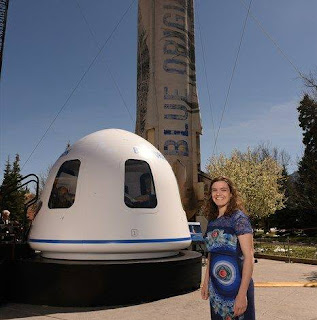The Congressional Gold Medal, our nation's highest civilian honor, has been given over 200 times. Fewer than 10% of the medals have been received by women and just five (5!) have been awarded for outstanding contributions in air and space exploration. The good news is that legislation to award Gold Medals to the “Hidden Figures” is
moving forward and the better news is that momentum is building to also support a nomination for the First Lady Astronaut Trainees (FLATs), also known as the “Mercury 13”.
I first learned about these women when I read
Martha Ackmann's book and had the privilege of meeting both Martha and Wally Funk, one of the FLATs, when they visited Albion College in 2008. As a result of this visit, I have started a campaign to nominate this group of 13 women aviators for the Congressional Gold Medal.
The FLATs were tested for “the right stuff” by NASA doctor William Lovelace almost 60 years ago and proved themselves to be just as good as, if not better than, the Mercury 7 astronauts in withstanding extreme physical and psychological tests. Results of the tests eventually lead to the inclusion of women within NASA’s astronaut corps, with
Sally Ride paving the way for American women in 1983 and
Eileen Collins becoming the first female pilot to command a space shuttle in 1995.
 |
| Members of the FLATs, at the launch of shuttle pilot Eileen Collins in 1995 (NASA image). |
In the current era of renewed interest in space exploration, and in the spirit of the 50th anniversary of Apollo 11, I believe it is imperative to recognize the 13 FLATs, six of whom are still alive, for their trailblazing accomplishments that demonstrated women are just as capable and qualified as men in the exploration of space. These women are:
Jerrie Cobb (Oklahoma)
Wally Funk (New Mexico)
Myrtle “K” Cagle (North Carolina)
Gene Nora Stumbough [Jessen] (Oklahoma)
Rhea Hurrle [Woltman] (Colorado)
Sarah Gorelick [Ratley] (Kansas)
Irene Leverton (Illinois, now deceased)
Jane B. Hart (Michigan, now deceased)
Jerri Sloan [Truhill] (Texas, now deceased)
Bernice “B” Trimble Steadman (Michigan, now deceased)
Jan Dietrich (California, now deceased)
Marion Dietrich (California, now deceased)
Jean Hixson (Illinois, now deceased)
To support the nomination of the FLATs for the Congressional Gold Medal,
sign the petition and/or contact your local representative. Thank you!
Read more:





